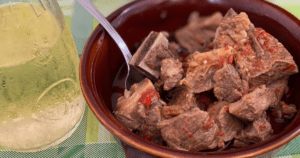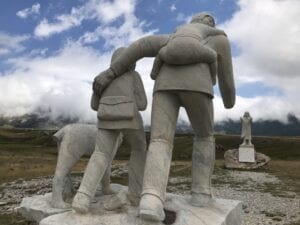
 Abruzzo has lost Pierluigi Imperiale, a vet with a passion for bringing the well-trod old pastoral paths of the transumanza back to life. For anyone who has recently walked along the Tratturo Magno (The Royal Shepherd’s Path) from L’Aquila, you will probably be here through the actions and activism of this individual, who refused to let the ancient footsteps of seasonally driven livestock become forgotten over the last few decades.
Abruzzo has lost Pierluigi Imperiale, a vet with a passion for bringing the well-trod old pastoral paths of the transumanza back to life. For anyone who has recently walked along the Tratturo Magno (The Royal Shepherd’s Path) from L’Aquila, you will probably be here through the actions and activism of this individual, who refused to let the ancient footsteps of seasonally driven livestock become forgotten over the last few decades.
We met him a decade ago in 2012 with Let’s Blog Abruzzo when he gave a colourful insight into the heritage of the region. A piece he wrote for us, translated by Helen Free remains ever important when considering walking in Abruzzo, or uncovering its socio and economic history and future, particularly on ways to harness tourism sustainably for the region that respects its fragile ecosystem. We hope his Facebook group remains active and continues his ever-important work. A measure of how important his activity and promotion of this cultural event was worldwide was in 2019 when UNESCO added the transumanza onto its list of Intangible Cultural Heritage of Humanity.
First, a Look Back
There is serious talk since the 2006 earthquake of designating L’Aquila as a Smart City. The foundations for a Smart City are already in place: a natural environment and strong regional heritage, and an intellectual climate conducive for high technology, innovation, and energy independence.
Let me be clear that L’Aquila is not renouncing its longstanding social and environmental values. L’Aquila’s recovery is contingent upon its continued relationship with centuries-old traditions and historical contexts. In this way, L’Aquila can simultaneously maintain who we were and who we are now.
For example, the historic identity of this city has always been strongly connected to the pastoral culture, but since the 20th-century residents have identified more with the academic culture at the University or with civic work in Public Administration and Services. Industries thrived for a time after the war, but as many as 5,000 workers lost jobs in the 80s. Since L’Aquila’s founding by Federico II’s family, the city has been rebuilt several times due to earthquakes.
The reason that L’Aquila has revived time after time is due to the sheep breeding industry which has remained a constant. The natural richness of the mountains has offered the necessary resources to work again when other industries were lost. In the “cratere” 50,000 sheep are still bred throughout the year and an additional 20,000 come here ‘in transhumance’.
Tratturo Magno names the ancient paths where shepherds moved the flocks from Abruzzo’s highlands (in summer) back to Foggia’s Tavoliere (in winter). This track was owned by the king to be used for the grazing of 2 million sheep during the 3-week trek. Over the centuries herds were taxed through the Dogana della Mena delle Pecore in Puglia. The main product was the wool, sold in the great market of Foggia and worked in the workshops of L’Aquila. The dresses of Florence’s Renaissance were all made here; the magnificent buildings of L’Aquila were realised thanks to this trade. Some say that the ancient walls of L’Aquila’s buildings are made of wool and the old businesses smell of cheese!
The King’s Track Today and Tomorrow
Today we must build on our pastoral past as we conceptualise rebuilding L’Aquila. We need a new strategy to actualize green areas inside the historical monuments, new little masterpieces in existing open spaces (like Renzo Piano’s Auditorium) and a “greenway” following the Tratturo Magno from The Basilica of Santa Maria di Collemaggio to Onna, San Gregorio, Castelnuovo. All these rural villages have been dramatically struck by the 2009 earthquake. The use of this path for cycling or walking, for leisure and the arts, should be the modern interpretation of these public areas which still remain ‘State’ property. We need a good master plan that connects the consciousness of our past to serve our cultural roots for the future.
Each year my group TracturoMagno walks along the 244 kms from L’Aquila to Foggia. As we walk , we monitor the conservation needs along this heritage trail. Since 2009 we have seen many monuments of the past damaged by the earthquake: ancient walls, some entrance columns, one loggia, an arch, a tower… in ruin. Still safe is a wonderful tiny church, 4 kilometres from L’Aquila in S. Elia, unique for its architecture. The church has no frontal door, just two small doors on the side walls to allow the passing of sheep one by one in front of the altar, dedicated to S. Maria Immacolata, who is trampling the snake.
The shepherds would walk into the church with their cap in hands to save themselves and their sheep from the dangerous bites of vipers. Walking on, the trekker arrives at Peltuinum (a Roman city), then to S. Maria di Cinturelli and to some strange heart-shaped caves…and so on.
Every year we discover new little treasures like these and we make new friends along the way. Together we work to envision a new, modern life for Tratturo Magno, with more and more people enjoying this natural and historical richness. We like to call ourselves “a flock of hoofing ideas” or “a work-in-walk.”
Note
It has been announced the annual group walk that he organised from L’Aquila down to Foggia in Puglia will still take place in 2022 despite the loss of Pierluigi, departing on the 29th of September from Piazzale di Collemaggio and arriving in Piazza dell’Epitaffio, Foggia on the 6th October 2022. Contact the group for more information on their Facebook page.
Photos by Pete Austin







